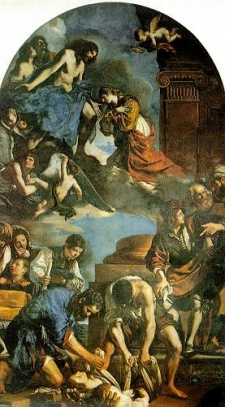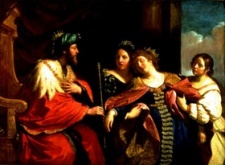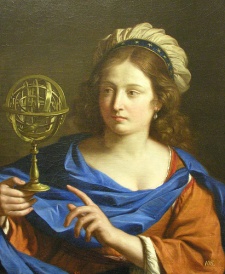Comparisons with the Secondo Maniera of Guercino
<embed> <script src="http://www.google-analytics.com/urchin.js" type="text/javascript"> </script> <script type="text/javascript"> _uacct = "UA-1465794-1"; urchinTracker(); </script> </embed> <embed><meta name="google-site-verification" content="toTg44fT--2S316skb_1o9xcO2DmcXYMLNhs7kZVnv8" /></embed>
Comparisons with the Secondo Maniera of Guercino
Introduction
The Baroque period was a time of rapid transition when the Italian arts evolved into a more textured and deeper medium of personal expression. Guercino, a young savant from the small northern town of Cento, was highly influenced by the Carracci’s among others who focused on a bold new form of naturalism. Over Guercino’s long lifetime, his Prima Maniera featuring bold compositions with strong lighting and shading learned in the north, yielded ever more to his Secondo Maniera which employed a subtle palette with a more refined classical style. Guercino’s late in life work The Personification of Astrology (1655) serves as a strong guidepost for a retrospective on his illustrious career. We will start with a comparison to his widely acknowledged seminal work The Burial of Saint Petronilla (1623), created during his short but productive Roman period, before looking at a midlife work Esther before Ahasuerus (1639).
Success in Rome: The Burial of St. Petronilla (1623)
Guercino formed the ideas leading to his Prima Maniera from his hometown of Cento, in the independent Emilia region of Italy where the Carracci’s Bolognese school dominated the somewhat isolated region. Works from the school greatly influenced Guercino’s naturalistic style, which featured strong lighting and shading choices. Guercino’s bold take on this chiaroscuro style impressed powerful religious patrons, eventually leading him to Rome in 1621 after much success in the north. However, “His early naturalistic chiaroscuro style, so successfully practiced in Emilia, was not highly regarded in the sophisticated Roman court milieu in which he then found himself” [1]. Two years later, The Burial of Saint Petronilla (1623) showed the court a radical reorientation of his Prima Maniera style that was as bold as his previous efforts, but exuded a new level of refinement.
The Burial of Saint Petronilla dramatically depicts Saint Petronilla’s burial in the lower half of the altarpiece, before her ascent to heaven in the upper half. The two halves show a distinction in Guercino’s stylistic development, as the death scene contains strong chiaroscuro characteristics, while the heaven scene changes to a more subtle classical style. The altarpiece enters near complete blackness in the lower right corner obscuring all detail while St. Petronilla is portrayed a short distance away in a vivid white. The shadows also obscure detail in the clothing of the figures burying her, leading to an overall confused and tense atmosphere [2]. Conversely, the shadows on the Christ in the upper left corner of the heaven scene compliment his form, rendering him in more detail. Much later in the Personification of Astrology (1655), Guercino has ceded to his subtler Secondo Maniera using the same type of shadowing on the astrologer as on the Christ. The astrologer is revealed fully with the shadowing gradually accentuating her figure without ever obscuring her. Rather than popping out of the image like the main figures in the lower burial scene, the astrologer finds unity with her background as very little distinguishes where her hair ends and the background begins. The subtlety of the astrologer’s representation is a strong visual hallmark of Guercino’s Second Maniera, which was earliest realized in the Christ figure of the St. Petronilla altarpiece. Perhaps this visual “reorientation” was due to pressures from the critical court, or a natural evolution of Guercino’s style after being exposed to new artistic ideas upon his arrival in Rome.
The Burial of St. Petronilla (1623) develops narrative based strongly on the natural inclination of the human eye trace. The eye naturally looks for rhythm and movement with a vertical S-curve as psychologically the most pleasing to follow [3]. In this way, Guercino seems more aware of the beholder than before, possibility because he knew the destination of the altarpiece in Saint Peters Basilica, unlike typical commissioned painting. The beholder must look up to see the scene starting at the bottom, first being drawn to the prominent figure in blue with deep chiaroscuro shadowing. (Mahon 208). The eye next naturally travels over the body of St. Petronilla before continuing up and to the right. Upon reaching the right edge in the middle of the altarpiece, the beholder’s eye will drift back to St. Petronilla bowing before Christ, ending with the image of a forgiving lord. The Personification of Astrology (1655) incorporates this same logic, starting with the astrologer’s face as the focal point. The beholder is next drawn to the object of the gaze, settling on a golden astrolabe modeling the solar system. Guercino then takes his relationship with the beholder to a more complex level by creating a visual circuit in the viewer’s mind. After seeing the astrolabe, the eye moves to the figure’s hand extended over her body. The hand however points directly back to the astrolabe, which in turn brings the eye back to the face following the vertical S-curve, which immediately gazes back upon the Astrolabe. Creating this visual circuit shows Guercino’s deep concern with the relationship between the work and the beholder. The importance of the beholder becomes steadily more prominent throughout his career, though his overall visual style becomes more subdued after his return from Rome.
Death of Pope Gregory XV: Esther before Ahasuerus (1639)
The Death of Pope Gregory XV in 1623 ended Guercino’s brief career in Rome, with the loss of his strong network of Vatican patronage. Guercino returned to Cento with new stylistic viewpoints, learned in part from the works of fellow Roman contemporaries who were seen less critically in the eyes of the court. A particular contemporary named Guido Reni “heralded a fundamental change in his (Guercino’s) work. Henceforth there was a lightening of his palette and a tendency to make the spatial setting of his figures more lucid” [4]. Like Guercino, Reni hailed from the northern Emilia region of Italy, studying and refining his art in Bologna. However, Reni’s sensuous compositions always remained extremely popular with the patrons of Rome as well as Bologna. Guercino’s style grew closer to the conventions used by Reni throughout this period, though Esther before Ahasuerus (1639) still betrays the roots of his Prima Maniera, despite moving closer to the stylistic choices seen in The Personification of Astrology (1655). The Esther story remains an emotionally charged narrative despite “represent[ing] a later phase of the painter’s career, when classical theories exerted a certain formal and emotional restraint in his work” [5]. Esther is seen swooning before the Persian King Ahasuerus, after defying death to plead with him to stop the massacre of her Jewish people. Esther’s self-sacrifice was later modified to reflect church teachings, and became a popular subject matter among religious depictions. The Catholic Church came to portray Esther as the Immaculate Virgin in her role of intercessor on the Day of Judgment in church iconography [6]. The King in his symbolic God role grants Esther’s request with the wave of his golden scepter, which causes her to faint into the arms of the surprised chambermaids. Through subtle symbolism, The Personification of Astrology (1655) also hints at the notion of the Immaculate Virgin. Biblical symbolism tells that The Virgin of the Immaculate Conception is crowned with a circle of stars [7]. The female astrologer figure also displays a row of stars across her hair cover. Going with the notion of the astrologer as the Immaculate Virgin finalizes Guercino’s Secondo Maniera, as even the narrative takes an element of subtlety.
Later Years in Bologna: The Personification of Astrology (1655)
Art from his final period exhibits a refined subtlety in part due to the death of his chief competitor Guido Reni in 1640. One year before Reni’s death, Esther before Ahasuerus (1639) exhibits the final trademarks of his Prima Maniera mostly in the figure King Ahasuerus. Unlike the lucidly intertwined Esther, Ahasuerus is painted alone with aggressive coloring in his ornate jewelry, and at an emotional distance due to “Guercino’s Technique of filling in the eyes with dark blotches of ink keep[ing] us from reading clearly the emotional import of the figure’s (Ahasuerus) gaze” [8]. Esther before Ahasuerus (1639) acts as a final link between the two distinct styles of Guercino with its mostly lucid compositions, despite the lone Ahasuerus figure painted in bold chiaroscuro. Two years later, Guercino moved his entire extended family from Cento to Bologna partly to escape the Wars of Castro, but probably also to work for the former patrons of the late Guido Reni. During his final Bologna period, Guercino painted few figures as bold and emotionally distant as King Ahasuerus. Reni’s former patrons were used to his refined classical style, which Guercino fully incorporated into his own work.
The subtle visual and narrative choices shown in The Personification of Astrology (1655) stand in stark contrast to the boldly naturalistic style of Guercino’s youth. Beginning with his Roman masterwork The Burial of Saint Petronilla (1623), Guercino exhibits his newfound refinement in the figures of the upper half of the altarpiece. This refinement continues to gain prominence upon his return to Cento and the ensuing competition with Guido Reni. Upon Reni’s death, the bold choices of his youth seen partially in Esther Before Ahasuerus (1639) give way completely to the refined aesthetic enjoyed by Reni’s northern art patrons. Both Manieras have much to offer art history, and paint an illustrative story of Guercino’s motivations throughout his lifetime.
References
Works Cited
Primary
- Guercino. The Burial of St. Petronilla. 1623. Musei Capitolini, Rome, Italy.
- Guercino. Esther Before Ahasuerus. 1639. Michigan Museum of Art, Ann Arbor, Michigan.
- Guercino. The Personification of Astrology. 1655. Blanton Museum of Art, Austin, Texas.
Secondary
- Block, Bruce. The Visual Story, Second Edition. New York: Focal, 2007. Print.
- Hall, James A. Hall's Dictionary of Subjects and Symbols in Art. New York: Richard D. Irwin, 1985. Print.
- Mahon, Denis. Guercino master painter of the Baroque. Washington: National Gallery of Art, 1992. Print. 205-211.
- Plummer, Ellen A. In focus, Guercino's Esther. Ann Arbor: University of Michigan Museum of Art, 1993. Print.
- Turner, Nicolas. "Guercino." Grove Art Online. Oxford Art Online. 27 Sep. 2009 [1].


